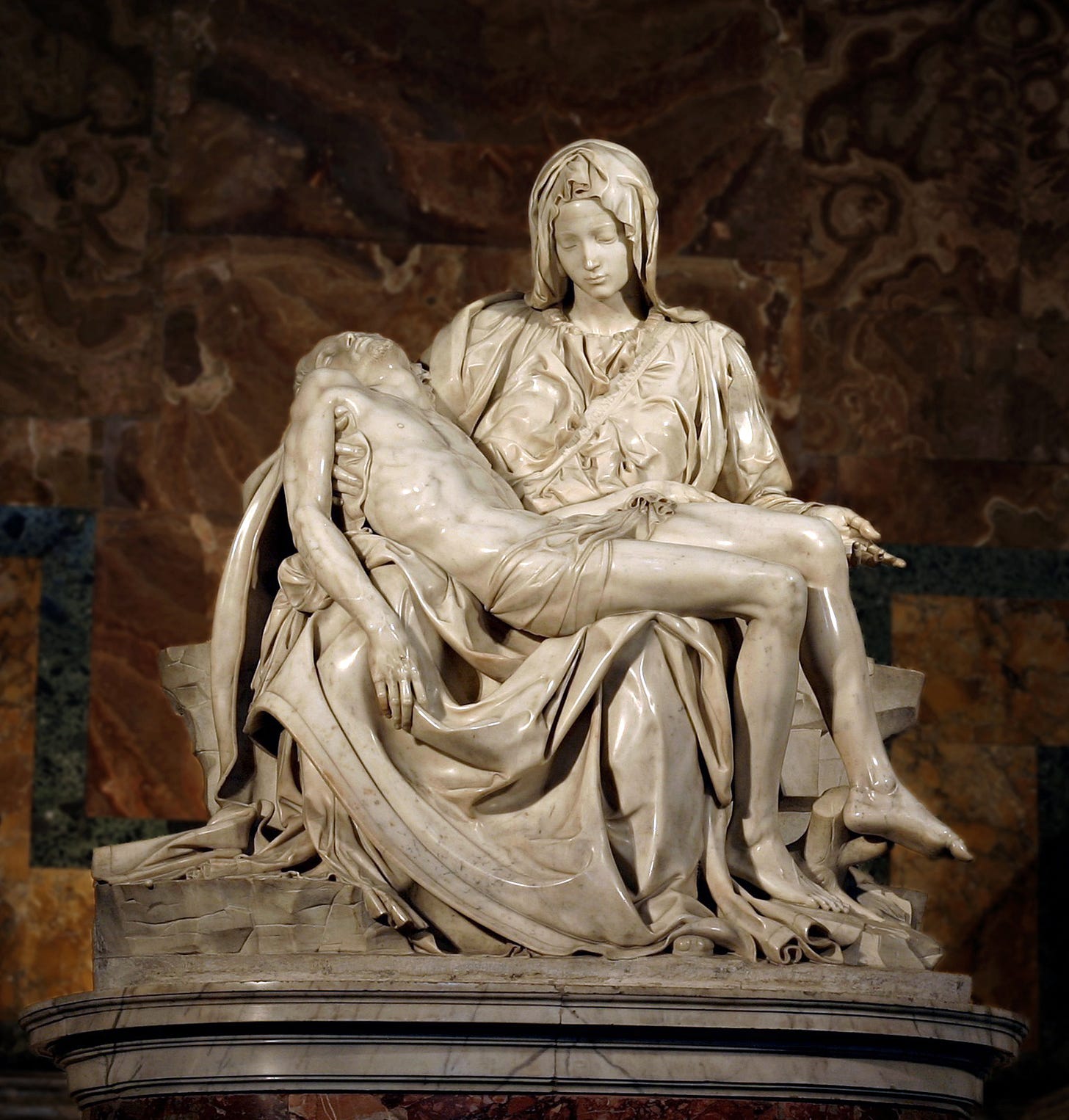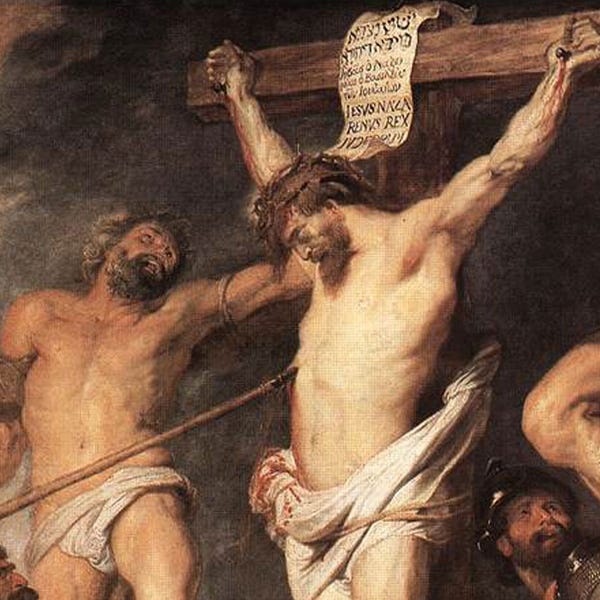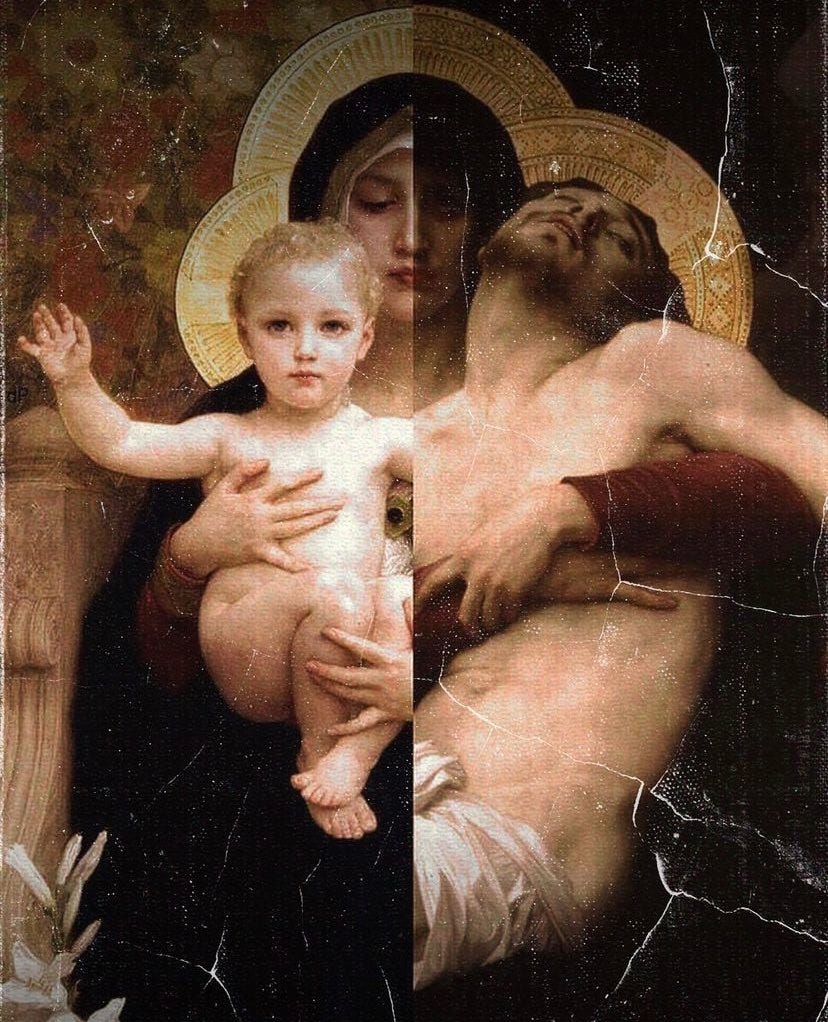Our Lady of Sorrows Pt. VII
The Piercing and Taking Down from the Cross
The previous article can be found here.
Two Great Mysteries
As the sorrows of Mary have been handed down through the centuries, two mysteries have been listed as the sixth sorrow: that of the piercing of the side of Christ after His death and that of His descent from the cross. I have continually cited St. Alphonsus Liguori for this series, and he treats both of these mysteries in The Glories of Mary. To that end, I will treat both for this article.
“…when they look on Him whom they have pierced, they shall mourn for Him, as one mourns for an only child, and weep bitterly over Him, as one weeps over a firstborn.” Zechariah 12:10
The Piercing of the Side of Christ
Within the Passion narratives, St. John records that Pilate was asked to expedite the death of the Lord and the two crucified with Him, since it was the Day of Preparation.1 To do this, he commanded the guards to break the legs of the crucified. St. John records that when they came to break the legs of the Lord, they “saw that He was already dead.”2 Instead of breaking His legs, they pierced His side with a lance, and this, as John makes note, was to fulfill the scriptures that no bone would be broken3 and that they would look upon Him who they have pierced.4
St. John tells us that as a result of the piercing of His side, “at once there came out blood and water.”5 There are several allusions that this piercing brings to light:
First, the connection to the Temple would have been obvious to first-century Jews. In the temple, there was a water system which was used to wash the immense amount of blood away from all of the sacrifices. This was called the Gihon Spring. It would wash out of the temple through its side and out into the Kidron Valley. The blood and water coming out of the side of the Temple are perfected in the blood and water pouring forth from the side of Christ, the new Temple.6
Second, the Fathers of the Church7 frequently saw the piercing of the side of Christ as a fulfillment of Eve being taken from the side of Adam.8 Just as the bride of Adam was taken from his side, so too is the Church, the Bride of Christ, born out from His side.9
Finally, St. Thomas Aquinas points to the blood and water which flow from the side of Christ, representing the two principal sacraments of Baptism and the Eucharist. He writes:
“Water flowed from Christ’s side to wash us; blood, to redeem us. Wherefore blood belongs to the sacrament of the Eucharist, while water belongs to the sacrament of Baptism.”10
Reflecting on the suffering of Our Lady during this event, she witnesses more cruelty being inflicted on the precious body of her beloved Son. He was already dead. No doubt, she thought the offenses befalling Him were over and He would finally be at rest. Scarcely had she begun mourning His death when soldiers came to break His legs! St. Alphonsus quotes St. Bonaventure, who tells us that it was actually Mary who begged the soldiers not to break His legs since He had already died! Imagine the immense suffering of Our Lady trying to protect the precious body of Our Lord from more sacrilege at the hands of the Romans.
Instead of breaking His legs, the soldiers pierced His side with a spear. The revelations to St. Bridget say that His heart was divided into two!11 St. Alphonsus writes:
“The injury of that stroke was inflicted on Jesus, but Mary suffered its pain. ‘Christ’ says the devout Lanspergius, ‘shared this wound with His Mother; He received the insult, His mother endured its agony.’”12
Immediately, the devout soul ought to remember the Prophecy of St. Simeon:
“Simeon blessed them and said to Mary His mother, ‘Behold, this child is set for the fall and rising of many in Israel, and for a sign that is spoken against (and a sword will pierce through your own soul also), that the thoughts of many hearts may be revealed.” Luke 2:34-35.
The Fathers of the Church teach us that this is literally the sword that was prophesied all those years prior. While this was not a physical sword, it was a sword of great suffering inflicted on the heart of the most pure Virgin. To that end, St. Bernard writes:
“The lance which opened His side passed through the soul of the Blessed Virgin, which could never leave her Son’s heart.”13
Our Lady compassioned her beloved Son, who, since He was already dead, did not physically suffer the piercing of His Sacred Heart. But in her most Immaculate Heart, she felt the thrust of the spear and so was united to her Son as she underwent her own spiritual death. In her innermost soul, she resides in the pierced side of her Son, closest to His heart. She beckons her faithful children to join and find consolation in the pierced heart of the Eternal Son.
The Descent from the Cross
“Holding her Son in a silent embrace, she sat immobile, as if transfixed again by the sword of sorrow, or like one frozen by the chill winds of death.”14
All four Gospels tell us that Our Lord was taken down from the cross at the request of Joseph of Arimathea. While the Gospels speak of Him then placed in the tomb, the oral tradition of the Church, as well as common sense, tell us that He was first laid in the arms of His mother so that she might cradle His precious body in her arms.
St. Alphonsus writes:
“It was revealed to St. Bridget, that three ladders were placed against the cross to take down the Sacred Body; the holy disciples first drew out the nails from the hands and feet and, according to Metaphrastes, gave them to Mary. Then one supported the upper part of the body of Jesus, and the other the lower, and thus descended it from the cross.”15
This scene must have struck onlookers with immense sorrow. The Sorrowful Mother receives her son into her arms and mourns as she holds her Son and her God. It was in these moments that Our Lady, who desired so greatly to embrace her Son along the road of the Passion, held His lifeless body in her arms. The sacrifice which she herself had offered was finished, and she could finally lay her beloved to rest.
As Our Lady held the still body of her Son, she would have remembered back to holding her infant Son during His childhood. The dichotomy presented in that thought is powerful. Both at the beginning of His life and at the end, she holds Him in her arms in constant adoration of His divine person. In the end, she herself closes the eyes of her Son so that He can sleep the sleep of death as St. Alphonsus tells us:
“Our Blessed Lady herself revealed to St. Bridget, that ‘she closed the eyes of her Son, when He was taken down from the cross, but she could not close His arms;’ Jesus Christ giving us thereby to understand that He desired to remain with His arms extended to receive all penitent sinners who return to Him.”16
She closes the eyes of her Son just as His eyes would close while falling asleep in her arms as an infant. She cradles Him in the same way she did back then. Except now, instead of the joy that accompanies motherhood, she is stricken with the most intense sorrow there is, that of a parent holding her dead child. This is a pain that Our Lady is close to for all those who must carry the cross of the death of a child. She is near to all who endure this. Lovingly holding those same parents as they endure a measure of what she endured.
Even so, the hope of the resurrection remains. St. Anselm writes:
“If anyone is able, let them describe to me the bitterness of the sorrow which then pierced her most tender and Immaculate Heart! But I do not believe that her pain may ever be truly or adequately described. Nevertheless, her grief, while immense and inconceivable, did not become impious despair. For despair lacks hope, and the lack of hope implies the lack of faith. Although Mary’s tears flowed without restraint and although her agony of grief was unbounded, yet still she believed (or rather, knew) deep within her heart that her Son would rise gloriously from the tomb on the third day.”17
It is time for Mary to accompany her Son on one last stop along this road of sorrows. It is after her time of mourning, no doubt cut short by the impending sunset, that she will accompany the body of her Son to the tomb. Here, she will lay Him to rest as she anticipates the resurrection in hope.
Let us pray,
O most sorrowful Mary, I compassionate that wound which thy mournful heart endured from the lance which tore the side of Jesus and wounded His most lovely heart. O beloved Mother, by thy heart then pierced through, obtain for me the virtue of fraternal charity and the gift of understanding.18
Hail Mary…
Cf. John 19:31.
John 19:33.
See Exodus 12:46. The Israelites were commanded to take an unblemished lamb as their sacrifice and specifically commanded not to break any of its bones. This Passover lamb prefigures Christ, our own sacrifice, who is slaughtered and then consumed.
See Zechariah 12:10.
John 19:34.
John 2:21.
For example, St. Augustine writes, “To prefigure this, the woman was made out of the side of the sleeping man; for this second Adam bowed His head, and slept on the cross, that out of that which came forth, there might be formed a wife for Him.” St Augustine, Tractates on John, CXX.
Cf. Genesis 2:21-23.
Cf. Ephesians 4:31-32.
Saint Thomas Aquinas, Summa Theologiae, IIIa q. 66, a. 3.
Revelations Bk ii, c. 21.
St. Alphonsus Liguori, The Glories of Mary, 441.
In Sign. Magn.
St. Anselm of Canterbury, The Passion of Christ through the Eyes of Mary, 81.
The Glories of Mary, 442-443.
Ibid. 444.
St. Anselm of Canterbury, The Passion of Christ through the Eyes of Mary, 82.
Blessed Be God, Preserving Christian Publications: Boonville, NY, 2022.





My beloved son, Dominic, died when he was 35, at the Mayo Clinic 12.16.19. There is NO greater grief than to see your child take their last breath, and to bury their remains. I bought a statue of the Pieta so that I can always look at, remember and take comfort in the fact that Our Lady experienced the exact same sorrow. +JMJ+
Saint Faustina and the rays of Divine Mercy are relevant to the blood and water.
https://www.thedivinemercy.org/articles/what-meaning-rays
Diary 299 speaks to the blood and water.
O Blood and Water, which gushed forth from the Heart of Jesus, as a fount of mercy for us, I trust in You. (89)